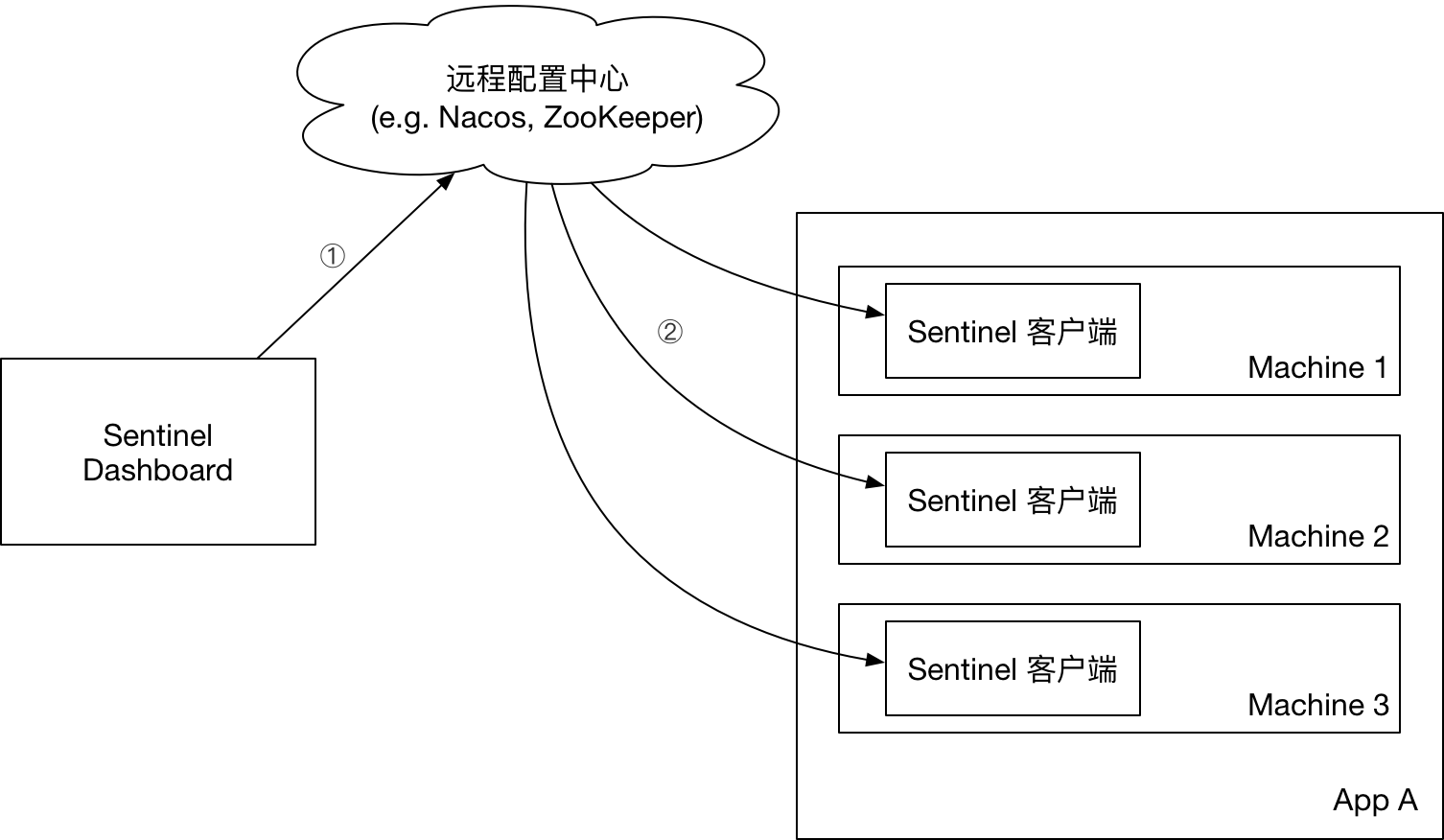前言
Sentinel 原生版本的规则管理通过API 将规则推送至客户端并直接更新到内存中,并不能直接用于生产环境。不过官方也提供了一种 Push模式,扩展读数据源ReadableDataSource,规则中心统一推送,客户端通过注册监听器的方式时刻监听变化,比如使用 Nacos、Zookeeper 等配置中心。这种方式有更好的实时性和一致性保证。这里我们通过配置 Nacos 来实现流控规则的统一存储配置。
架构
控制台推送规则至配置中心,客户端通过监听事件从配置中心获取流控规则。
客户端配置
pom.xml 引入:
<dependency>
<groupId>com.alibaba.csp</groupId>
<artifactId>sentinel-datasource-nacos</artifactId>
<version>1.6.3</version>
</dependency>
配置文件:
# nacos的访问地址,配置参考 https://blog.52itstyle.vip/archives/4174/
spring.cloud.sentinel.datasource.ds.nacos.server-addr=47.104.187.19:8848
#nacos中存储规则的dataId,对于dataId使用了${spring.application.name}变量,这样可以根据应用名来区分不同的规则配置
spring.cloud.sentinel.datasource.ds.nacos.dataId=${spring.application.name}-flow-rules
#nacos中存储规则的groupId
spring.cloud.sentinel.datasource.ds.nacos.groupId=SENTINEL_GROUP
#定义存储的规则类型
spring.cloud.sentinel.datasource.ds.nacos.rule-type=flow
控制台配置
修改 pom.xml,原来的<scope>test</scope>去掉:
<dependency>
<groupId>com.alibaba.csp</groupId>
<artifactId>sentinel-datasource-nacos</artifactId>
</dependency>
把 src/test 下面的包 com.alibaba.csp.sentinel.dashboard.rule.nacos 拷贝到src/main/java 下面。
修改 NacosConfig:
/**
* @author Eric Zhao
* @since 1.4.0
*/
@Configuration
public class NacosConfig {
@Value("${nacos.address}")
private String address;
@Bean
public Converter<List<FlowRuleEntity>, String> flowRuleEntityEncoder() {
return JSON::toJSONString;
}
@Bean
public Converter<String, List<FlowRuleEntity>> flowRuleEntityDecoder() {
return s -> JSON.parseArray(s, FlowRuleEntity.class);
}
@Bean
public ConfigService nacosConfigService() throws Exception {
Properties properties = new Properties();
properties.put("serverAddr",address);
return ConfigFactory.createConfigService(properties);
}
}
application.properties 配置引入 Nacos:
# nacos的访问地址,配置参考 https://blog.52itstyle.vip/archives/4174/
nacos.address=47.104.197.19:8848
FlowControllerV2 指定对应的 Bean 开启 Nacos 适配。
@Autowired
@Qualifier("flowRuleNacosProvider")
private DynamicRuleProvider<List<FlowRuleEntity>> ruleProvider;
@Autowired
@Qualifier("flowRuleNacosPublisher")
private DynamicRulePublisher<List<FlowRuleEntity>> rulePublisher;
修改sidebar.html页面, 流控规则路由从 dashboard.flowV1 改成 dashboard.flow
<-- nacos 动态规则配置-->
<li ui-sref-active="active" ng-if="!entry.isGateway">
<a ui-sref="dashboard.flow({app: entry.app})">
<i class="glyphicon glyphicon-filter"></i> 流控规则</a>
</li>
如图所示,界面会多了一个回到单机页面的按钮,这里我们新增一个流控规则。
登录 Nacos 后台,配置管理->配置列表:
点击进入配置详情,配置内容如下:
[{
"app": "blog",
"clusterConfig": {
"fallbackToLocalWhenFail": true,
"sampleCount": 10,
"strategy": 0,
"thresholdType": 0,
"windowIntervalMs": 1000
},
"clusterMode": false,
"controlBehavior": 0,
"count": 2.0,
"gmtCreate": 1568617671812,
"gmtModified": 1568622253889,
"grade": 1,
"id": 6,
"ip": "10.136.168.88",
"limitApp": "default",
"port": 8720,
"resource": "blogView",
"strategy": 0
}]
小结
生产环境下,推送规则正确做法应该是 配置中心控制台/Sentinel 控制台 → 配置中心 → Sentinel 数据源 → Sentinel。
案例
参考
点击查看更多内容
为 TA 点赞
评论
共同学习,写下你的评论
评论加载中...
作者其他优质文章
正在加载中
感谢您的支持,我会继续努力的~
扫码打赏,你说多少就多少
赞赏金额会直接到老师账户
支付方式
打开微信扫一扫,即可进行扫码打赏哦








